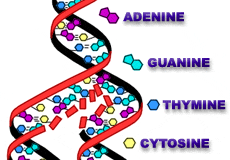| We live today. We are the result and the continuation of a long adventurous history. Our matter, the energy/mass of our bodies was originally formed billions of years ago shortly after (relatively speaking) the universe’s explosive origin. Over eons of nuclear churning in large distant stars, the different atoms here on Earth today were forged. This fusion process continues, along with the birth, life and death of countless stars in countless galaxies. Nurseries of the elements of matter, their death throes eject those atoms into space. Casting their seeds, the fruit of their burning lives and labors far away, to perhaps mingle and join with other things. To become something else. Some of those atoms and molecules of past novas and supernova joined in our galactic neighborhood and were part of the nebulous gases that eventually congealed into our solar system. Participating in the birth of our star...the sun. |
The Evolutionary History of Life
True, our sun is also an "alchemical" furnace and nuclear fusion is occurring there. However, our sun is of the type and size only able to turn hydrogen (the most abundant element) into helium. This means all the other atoms in our solar system came here from other stars. Novas and supernovas long, long ago and far, far away.We are made of star stuff. Nous sommes du soleil. The material foundation for what we recognize as LIFE on this planet is one particular molecule called DNA (Deoxyribonucleic acid). (I won’t go into RNA (Ribonucleic acid) viruses, proteins or other pre-biotic, or comet and asteroid theories for the origins of life here.) So here we are. We are a little different from the other molecules around us because we have cellular membranes, DNA, RNA, proteins, etc. We metabolize, synthesize and reproduce. And perhaps most distinguishingly, we actively respond to our environment. Maybe it should be looked upon as a part of it, instead of apart from it? After it had cooled considerably from its gaseous and molten state something interesting happened here on the planet Earth. Something, under those first conditions, about 3.5 to 4 billion years ago, began to have functionally organized types of molecules. Seemly going against entropy. These dead and inert molecules, collectively began taking on the characteristics we recognize as life. It all happened then, long ago and this initial birth or appearance of life on Earth has no evidence of happening again. It has not been replic ated since. We have no evidence of any other occurrence of spontaneous abiogenesis on Earth or any where else, yet. (Hear that SETI?) However since then there has been biogenesis. One of hallmarks of this life is reproduction, and apparently life here has been replicating itself, abundantly on this hospitable "pale blue dot". Over time, it has filled the world with the astonishingly beautiful bounty and diversity of its offspring. Life, the source of the organizing energy, itself is intangible. Whatever spark it is that animates molecules identical to other molecules that are dead, we have yet to understand it. We have yet to successfully replicate it. Dr. Frankenstein, notwithstanding, we have yet to bring dead matter to life. We can mix up all the right compounds and components, but still miss something. No spark, no ignition. However, if we do not see the cause we do see its manifestations and characteristics. Life can perhaps started in some molecules associating and functioning in an almost orchestrated or coordinated manner. But in the Earth environment of that time it is very likely that these first chemical associations though abundant, were only short and fleeting. Life truly manifested itself when the molecules survived in associations that, simply enough, had an outer shell (maybe a bubble of protein and/or lipids). Within a semi permeable shell, certain molecules and operations could proceed under more stable and constant conditions. |
CELL
Cells that created or maintained their shell perhaps had a better chance at survival. In time, the outer shell and the internal chemistry became modified and more elaborate. Single cell life forms, those with a membrane, a reproductive mechanism and using the abundant thermal and chemical energy of marine volcanic vents or of sunlight on the surface, flourished. These replicated in various ways including with mitosis, meiosis and recombinations of DNA, yielding descendants with variations.
The differences manifested were designed by code (recombination) and incidental events (mutational, developmental, environmental, epigenetic influences, etc), then subjected over time to the changing conditions they were naturally selected, just as they still are today.
Ok, so here's the finger pointing at the moon...
That first life is still here on this planet
It's still alive today
That original spark
is all the life around you
Science Shows Us
We Are One Life
|
Do we really have to continue to do this?
|
Carl Sagan - 1966 Interview on Astrobiology
|
Enjoy.
© 2012 MU-Peter Shimon





No comments:
Post a Comment
Let me know what you think. Questions and comments are welcome.